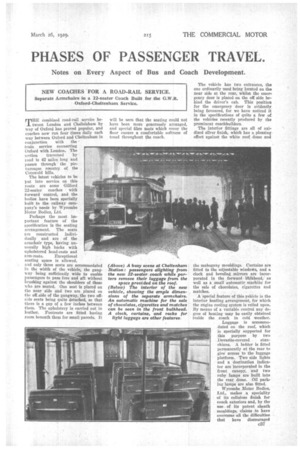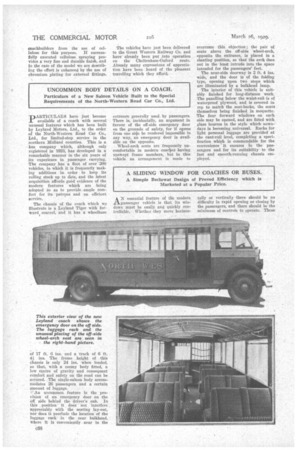PHASES• OF PASSENGER TRAVEL.
Page 67

Page 68

If you've noticed an error in this article please click here to report it so we can fix it.
Notes on Every Aspect of Bus and Coach Development.
NEW COACHES FOR A ROAD-RAIL SERVICE.
Separate Armchairs in a 22-seater Coach Built for the G.W.R. Oxford-Cheltenham Service.
rpRE combined road-rail service be
• 1 tween London and Cheltenham by way of Oxford has proved popular, and coaches now run four times daily each way between Oxford and Cheltenham in conjunction with the
train service connecting Oxford with London. The section traversed by road is 42 miles long and passes through the picturesque country of the Cotswold hills.
The latest vehicles to be put into service on this route are some Gilford 22-seater coaches with forward control, and the bodies have been specially built to the railway company's llePCIS by -Wycombe Motor Bodies, Ltd.
Perhaps the most important feature of the specification is the seating arrangement. The seats are constructed individually and are of the :Armchair type, having unusually high backs with upholstered head-rests and
arm-rests. Exceptional seating space is allowed, and only three seats are accommodated in the width a the vehicle, the gangway being sufficiently wide to enable passengers to pass fare and aft without brushing against the shoulders of these who are seated. One seat is placed on the near side and two are placed on the oft side of the gangway, the two offside seats being quite detached, so that there is a gap of a few inches between them. The upholstery is carried out in leather. Footrests are fitted having room beneath them for small parcels. It will be seen that the seating could not have been mare generously arranged, and special fibre mats which cover the floor ensure a comfortable softness of tread throughout the coach.
(Above) A busy scene at Cheltenham Station : passengers alighting from the new 22-seater coach while porters remove their luggage from the space provided on the roof.
(Below) The interior of the new vehicle, showing the ample dimensions of the separate armchairs. An automatic machine for the sale of chocolates, cigarettes and matches can be seen in the front bulkhead. A clock, curtains, and racks for
light luggage are other features.
The vehicle has two entrances, the one ordinarily used being located on the near side at the rear, whilst the emere gency door is placed on the off side behind the driver's cab. This position for the emergency door is evidently being favoured, for we have noticed it in the specifications of quite a few of the vehicles recently produced by the prominent coaehbuilders.
The interior fittings are all of oxidized silver finieh, which has a pleasing. effect against the white roof dame and
the mahogany mouldings. Curtains are fitted to the adjustable windows, and a clock and bevelled mirrors are ineorporated in the forward bblkhead,' as well as a small automatic machine' for the sale of chocolates, cigarettes and matches.
A -special feature of this vehicle is the interior heating arrangement, for which the engine cooling system is relied upon. By means of a variable control any degree of heating may be easily obtained inside the coach in cold weather. .Luggage is accommodated on the roof, which is specially supported for this purpose by two • i)overite-covered stenchions. A ladder is fitted permanently at the rear to give access to the luggage platform. Two side lights and a destination indicator are incorporated in the front canopy, and two ruby lamps are built into the rear dome. Oil parking lamps are also fitted.
Wycombe Motor Bodies, Ltd., makes a speciality of its cellulose finish for coach exteriors and, by the use of its patent sheath mouldings, claims to have overcome all the difficulties that have discouraged coachbuilders from the use of cel lulose for this purpose. If successfully executed cellulose spraying provides a very fine and durable finish, and in the case of the model we are describing the effect is enhanced by the use of chromium plating for external fittings.
The vehicles have just been delivered to the Great Western Railway Co. and have already been put into operation on the Cheltenham-Oxford route. Already many expressions of appreciation have been heard of the pleasant travelling which they afford.




























































































































